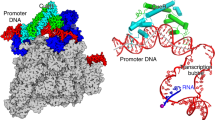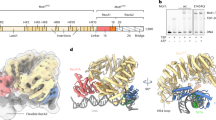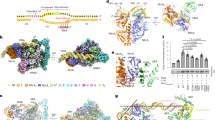Abstract
The general transcription factors (GTFs) of eukaryotic RNA polymerase II, in a process facilitated by regulatory and accessory factors, target promoters through synergistic interactions with core elements. The specific binding of the TATA box–binding protein (TBP) to the TATA box has led to the assumption that GTFs recognize promoters directly, producing a preinitiation complex at a defined position. Using biochemical analysis as well as biophysical single-pair Förster resonance energy transfer, we now provide evidence that negative cofactor-2 (NC2) induces dynamic conformational changes in the TBP–DNA complex that allow it to escape and return to TATA-binding mode. This can lead to movement of TBP along the DNA away from TATA.
This is a preview of subscription content, access via your institution
Access options
Subscribe to this journal
Receive 12 print issues and online access
$189.00 per year
only $15.75 per issue
Buy this article
- Purchase on Springer Link
- Instant access to full article PDF
Prices may be subject to local taxes which are calculated during checkout







Similar content being viewed by others
References
Stargell, L.A., Moqtaderi, Z., Dorris, D.R., Ogg, R.C. & Struhl, K. TFIIA has activator-dependent and core promoter functions in vivo. J. Biol. Chem. 275, 12374–12380 (2000).
Buratowski, S., Hahn, S., Guarente, L. & Sharp, P.A. Five intermediate complexes in transcription initiation by RNA polymerase II. Cell 56, 549–561 (1989).
Thomas, M.C. & Chiang, C.M. The general transcription machinery and general cofactors. Crit. Rev. Biochem. Mol. Biol. 41, 105–178 (2006).
Roeder, R.G. The role of general initiation factors in transcription by RNA polymerase II. Trends Biochem. Sci. 21, 327–335 (1996).
Albright, S.R. & Tjian, R. TAFs revisited: more data reveal new twists and confirm old ideas. Gene 242, 1–13 (2000).
Lewis, B.A., Sims, R.J., III, Lane, W.S. & Reinberg, D. Functional characterization of core promoter elements: DPE-specific transcription requires the protein kinase CK2 and the PC4 coactivator. Mol. Cell 18, 471–481 (2005).
Wright, K.J., Marr, M.T., II & Tjian, R. TAF4 nucleates a core subcomplex of TFIID and mediates activated transcription from a TATA-less promoter. Proc. Natl. Acad. Sci. USA 103, 12347–12352 (2006).
Sims, R.J., III, Mandal, S.S. & Reinberg, D. Recent highlights of RNA-polymerase-II-mediated transcription. Curr. Opin. Cell Biol. 16, 263–271 (2004).
Meisterernst, M. & Roeder, R.G. Family of proteins that interact with TFIID and regulate promoter activity. Cell 67, 557–567 (1991).
Inostroza, J.A., Mermelstein, F.H., Ha, I., Lane, W.S. & Reinberg, D. Dr1, a TATA-binding protein-associated phosphoprotein and inhibitor of class II gene transcription. Cell 70, 477–489 (1992).
Iratni, R. et al. Inhibition of excess nodal signaling during mouse gastrulation by the transcriptional corepressor DRAP1. Science 298, 1996–1999 (2002).
Prelich, G. & Winston, F. Mutations that suppress the deletion of an upstream activating sequence in yeast: involvement of a protein kinase and histone H3 in repressing transcription in vivo. Genetics 135, 665–676 (1993).
Kamada, K. et al. Crystal structure of negative cofactor 2 recognizing the TBP-DNA transcription complex. Cell 106, 71–81 (2001).
Goppelt, A., Stelzer, G., Lottspeich, F. & Meisterernst, M. A mechanism for repression of class II gene transcription through specific binding of NC2 to TBP-promoter complexes via heterodimeric histone fold domains. EMBO J. 15, 3105–3116 (1996).
Mermelstein, F. et al. Requirement of a corepressor for Dr1-mediated repression of transcription. Genes Dev. 10, 1033–1048 (1996).
Gilfillan, S., Stelzer, G., Piaia, E., Hofmann, M.G. & Meisterernst, M. Efficient binding of NC2.TATA-binding protein to DNA in the absence of TATA. J. Biol. Chem. 280, 6222–6230 (2005).
Albert, T.K. et al. Global distribution of negative cofactor 2 subunit-alpha on human promoters. Proc. Natl. Acad. Sci. USA 104, 10000–10005 (2007).
Gadbois, E.L., Chao, D.M., Reese, J.C., Green, M.R. & Young, R.A. Functional antagonism between RNA polymerase II holoenzyme and global negative regulator NC2 in vivo. Proc. Natl. Acad. Sci. USA 94, 3145–3150 (1997).
Xie, J., Collart, M., Lemaire, M., Stelzer, G. & Meisterernst, M. A single point mutation in TFIIA suppresses NC2 requirement in vivo. EMBO J. 19, 672–682 (2000).
Chitikila, C., Huisinga, K.L., Irvin, J.D., Basehoar, A.D. & Pugh, B.F. Interplay of TBP inhibitors in global transcriptional control. Mol. Cell 10, 871–882 (2002).
Geisberg, J.V., Holstege, F.C., Young, R.A. & Struhl, K. Yeast NC2 associates with the RNA polymerase II preinitiation complex and selectively affects transcription in vivo. Mol. Cell. Biol. 21, 2736–2742 (2001).
Klejman, M.P. et al. NC2alpha interacts with BTAF1 and stimulates its ATP-dependent association with TATA-binding protein. Mol. Cell. Biol. 24, 10072–10082 (2004).
Auty, R. et al. Purification of active TFIID from Saccharomyces cerevisiae. Extensive promoter contacts and co-activator function. J. Biol. Chem. 279, 49973–49981 (2004).
Myong, S., Rasnik, I., Joo, C., Lohman, T.M. & Ha, T. Repetitive shuttling of a motor protein on DNA. Nature 437, 1321–1325 (2005).
Amitani, I., Baskin, R.J. & Kowalczykowski, S.C. Visualization of Rad54, a chromatin remodeling protein, translocating on single DNA molecules. Mol. Cell 23, 143–148 (2006).
Cox, J.M. et al. Bidirectional binding of the TATA box binding protein to the TATA box. Proc. Natl. Acad. Sci. USA 94, 13475–13480 (1997).
Kapanidis, A.N. et al. Alternating-laser excitation of single molecules. Acc. Chem. Res. 38, 523–533 (2005).
Kapanidis, A.N. et al. Retention of transcription initiation factor sigma70 in transcription elongation: single-molecule analysis. Mol. Cell 20, 347–356 (2005).
Coban, O., Lamb, D.C., Zaychikov, E., Heumann, H. & Nienhaus, G.U. Conformational heterogeneity in RNA polymerase observed by single-pair FRET microscopy. Biophys. J. 90, 4605–4617 (2006).
Kapanidis, A.N. et al. Initial transcription by RNA polymerase proceeds through a DNA-scrunching mechanism. Science 314, 1144–1147 (2006).
Coleman, R.A. & Pugh, B.F. Evidence for functional binding and stable sliding of the TATA binding protein on nonspecific DNA. J. Biol. Chem. 270, 13850–13859 (1995).
Acknowledgements
We thank C. Goebel for excellent technical assistance, A. Lammens and D. Niessing for help with modeling of the TBP–DNA structure, T. Weil (Vanderbilt University) for providing the single-cysteine mutant of TBP, R.G. Roeder, L. Tora, P. Cramer and C. Bräuchle for crucial advice, and J. Michaelis (Ludwig Maximilian University Munich) for providing the MatLab software. This work was supported by grants from the Ludwig Maximilian University, Center for Nanoscience (CeNS), the German Excellence Initiative via the Nanosystems Initiative Munich and the Center for Integrated Protein Science (CiPS) Munich, Helmholtz Center Munich German Research Center for Environmental Health, and the Deutsche Forschungsgemeinschaft (SFB 646) to M.M. and D.C.L.
Author information
Authors and Affiliations
Contributions
P.S. built the single-molecule total internal reflection fluorescence microscope, performed all the single-molecule measurements, developed the analysis software and analyzed the single-molecule data. G.S. and E.P. performed biochemical analyses. D.C.L. and M.M. designed experiments and supervised the project.
Corresponding authors
Supplementary information
Supplementary Text and Figures
Supplementary Figures 1–8, Supplementary Table, Supplementary Discussion, Supplementary Methods (PDF 891 kb)
Rights and permissions
About this article
Cite this article
Schluesche, P., Stelzer, G., Piaia, E. et al. NC2 mobilizes TBP on core promoter TATA boxes. Nat Struct Mol Biol 14, 1196–1201 (2007). https://doi.org/10.1038/nsmb1328
Received:
Accepted:
Published:
Issue Date:
DOI: https://doi.org/10.1038/nsmb1328
This article is cited by
-
The global regulator Ncb2 escapes from the core promoter and impacts transcription in response to drug stress in Candida albicans
Scientific Reports (2017)
-
Defects in the NC2 repressor affect both canonical and non-coding RNA polymerase II transcription initiation in yeast
BMC Genomics (2016)
-
Hsp90 regulates the dynamics of its cochaperone Sti1 and the transfer of Hsp70 between modules
Nature Communications (2015)
-
Real-time observation of the conformational dynamics of mitochondrial Hsp70 by spFRET
The EMBO Journal (2013)
-
Structure and mechanism of the Swi2/Snf2 remodeller Mot1 in complex with its substrate TBP
Nature (2011)



